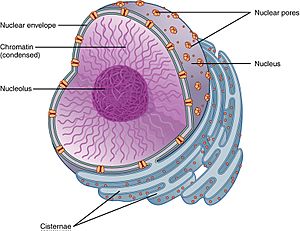Nuclear membrane facts for kids
The nuclear membrane, also known as the nuclear envelope, is a special protective layer around the nucleus inside a cell. Think of it like the wall of a castle that protects important treasures. Inside the nucleus, this membrane keeps the cell's genetic material, like DNA and chromosomes, safe. It also surrounds the nucleolus, which is a small part inside the nucleus.
This membrane is actually made of two layers, forming a double barrier. It's also connected to other parts of the cell's internal system, like the endoplasmic reticulum, which helps move things around the cell.
What are Nuclear Pores?
The nuclear membrane isn't completely solid. It has thousands of tiny openings called nuclear pores. These pores are like gates or doorways. They are made of large protein structures. Each pore is about 100 nanometers wide, with a channel about 40 nanometers wide.
These pores are very important because they control what goes in and out of the nucleus. They allow important molecules, like proteins and RNA, to move between the nucleus and the rest of the cell. This movement is vital for the cell to work properly.
Nuclear Membrane During Cell Division
Cells are always growing and dividing to make new cells. This process is called cell division. When a cell gets ready to divide, something interesting happens to the nuclear membrane.
During mitosis, which is a type of cell division, the nuclear membrane temporarily breaks down. This allows the chromosomes inside the nucleus to spread out and be properly sorted. Once the cell has divided into two new cells, a new nuclear membrane forms around the genetic material in each new cell. This ensures that each new cell has its own protected nucleus.
Images for kids
-
A detailed view of the nuclear envelope of a HeLa cell. This image was created using many slices from an electron microscope.
-
How the nuclear envelope breaks down and reforms during mitosis.
See also
 In Spanish: Envoltura nuclear para niños
In Spanish: Envoltura nuclear para niños





